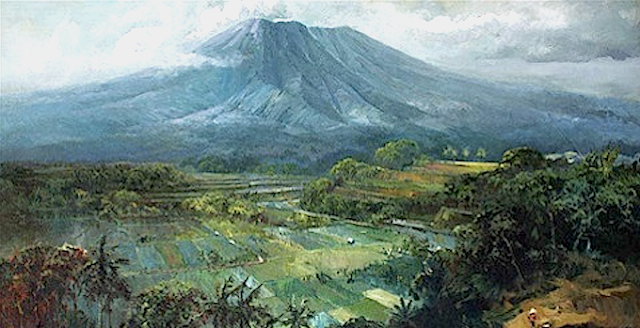BASOEKI ABDULLAH ( 1915-1993)
Gunung Bromo (2,329m - 7,641ft)
Indonesia (Java Timur)
In Permandangan Gunung Bromo, 1949, oil on canvas, Basoeki Abdullah Museum
The mountain
Gunung Bromo
(2,329m - 7,641ft) or Gunung Brama, an active volcano,in East Java, Indonesia, is not the highest peak of the Tengger massif, but the best known. The massif area is one of the most visited tourist attractions in East Java, Indonesia. The volcano belongs to the Bromo Tengger Semeru National Park. The name of Bromo derived from Javanese pronunciation of Brahma, the Hindu creator god. Gunung Bromo sits in the middle of a plain called the "
Sea of Sand" a protected nature reserve since 1919. The best way to visit Gunung Bromo is from the nearby mountain village of Cemoro Lawang, from where it is possible to walk during 45 mn to the volcano. It is also possible to take an organised jeep tour, which includes a stop at the viewpoint on Gunung Penanjakan (2,770 m - 9,088 ft).
On the fourteenth day of the Hindu festival of
Yadnya Kasada, the Tenggerese people of Probolinggo, East Java, travel up the mountain in order to make offerings of fruit, rice, vegetables, flowers and sacrifices to the mountain gods by throwing it into the caldera of the volcano. The origin of the ritual lies in the 15th century legend when princess Roro Anteng started the principality of Tengger with her husband, Joko Seger. The couple were childless and therefore beseeched the assistance of the mountain gods. The gods granted them 24 children but stipulated that the 25th child, named Kesuma, must be thrown into the volcano as a human sacrifice. The gods' request was implemented. The tradition of throwing sacrifices into the volcano to appease these ancient deities continues today and is called the
Yadnya Kasada ceremony. Though fraught with danger, some locals risk climbing down into the crater in an attempt to recollect the sacrificed goods that they believe could bring them good luck.
Depending on the degree of volcanic activity, the Indonesian Centre for Volcanology and Disaster Hazard Mitigation sometimes issues warnings against visiting Mount Bromo.
Mount Bromo recently erupted in 2004, 2010, 2011 and 2015.
The painter
Basoeki (or Basuki) Abdullah is one of a the modern master painters of Indonesia, known as a realist and naturalist painter. He has been appointed as the official painter of Merdeka Palace in Jakarta and works adorn palaces and presidential countries Indonesia, in addition to have been collectibles from around the world. His father, Abdullah Suriosubroto, was a famous painter and dancer, while his grandfather, Doctor Wahidin Sudirohusodo, was a prominent Indonesian National Awakening Movement in the early 1900's. Since the age of 4 years, Basoeki Abdullah began to paint famous personalities such as Mahatma Gandhi, Rabindranath Tagore and even Jesus Christ and Krishnamurti. His acquired a formal education in the Basoeki Abdullah Catholic and Catholic Mulo in Solo. In 1933, BasoekiAbdullah obtained a scholarship to study at the Academic Arts in The Hague, Netherlands, and completed his studies within 3 years with awarded Certificate of Royal International of Art (RIA). On 6 September 1948, during the revolutionary period, Basoeki Abdullah is housed in Amsterdam (Netherlands) during the coronation of Queen Juliana which held a contest to paint, Basoeki Abdullah defeated 87 European painters and managed to come out as winners.
Since then, the world began to recognize BasoekiAbdullah, during his frequent visits around Europe (Italy and France) and was well known by many resident artists with a worldwide reputation.
BasoekiAbdullah is famous as a portrait painter, especially painting the royal family and heads of state that tends to beautify or embellish persons. Aside from being an accomplished portrait painter, he too painted landscapes, mountains, fauna, flora, the themes of struggle, construction and so on.
Basoeki Abdullah held many solo exhibitions both domestically and abroad, among others, his work was exhibited in Bangkok (Thailand), Malaysia, Japan, the Netherlands, England, Portugal... Approximately 22 countries have Basoeki Abdullah paintings in their official collections. Most of his life was spent abroad including several years living in Thailand.








-%20%20Een%20berg%20in%20de%20Preanger%20-%201935%20Tropen%20museum%20.jpg)

-%20Pemandangan%20Sawa%20dan%20Gunung%20b.jpg)




